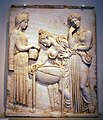
Sacrificial tripod
A sacrificial tripod, whose name comes from the Greek meaning "three-footed", is a three-legged piece of religious furniture used in offerings and other ritual procedures. This ritual role derives from its use as a simple support for a cooking vessel placed over a fire. As a seat or stand, the tripod is the most stable furniture construction for uneven ground, hence its use is universal and ancient.
Tripods had two types and several functions. Firstly, some oracles sat on large tripods to pronounce. Far more common were the tripods and bowls in which smaller sacrifices were burnt. These are particularly associated with Apollo and the Delphic oracle in ancient Greece. These were also given to temples as votive offerings, awarded as prizes in contests associated with religious festivals, and just given as gifts between individuals.




